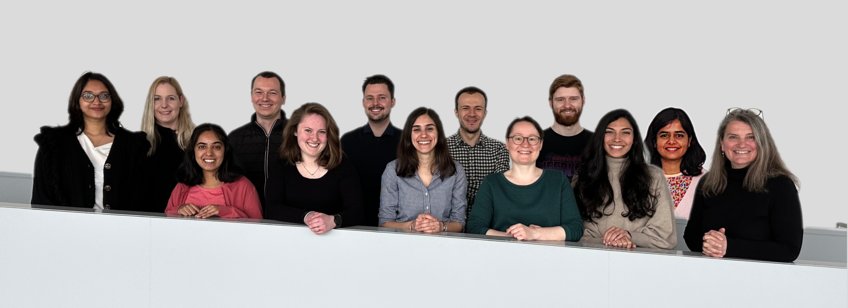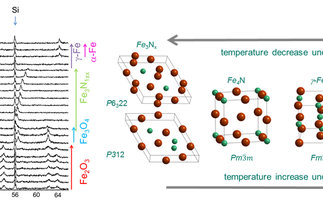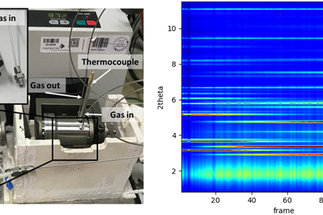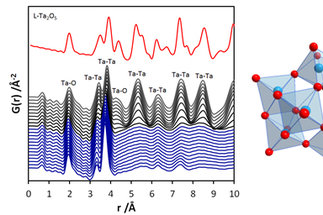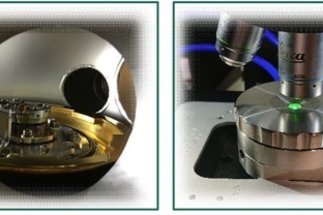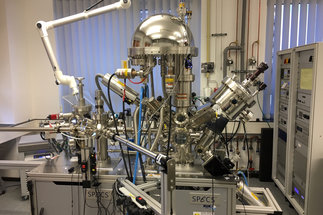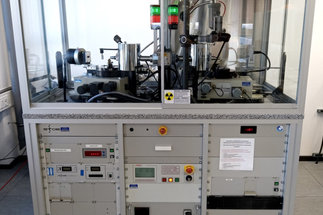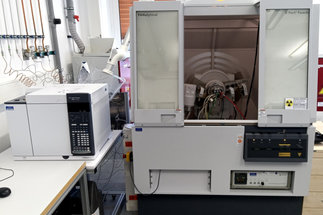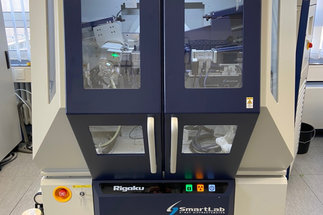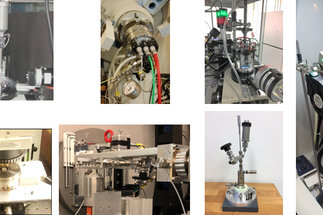Powder Diffraction and Surface Spectroscopy
The research activities of the group focus on crystallographic investigations of inorganic functional materials. These are used either as catalysts in chemical reactions or for energy storage and conversion. Structure-property relationships are studied on different length scales: from the averaged crystal structure to the local structure of amorphous or disordered compounds. The group has a long experience in the field of in situ diffraction. For in situ or operando investigations of structure-property relationships a variety of different sample environments are available, which are listed under "Instrumental Equipment".
The following topics are addressed with the help of diffraction methods:
• Phase identification, Rietveld refinements, quantitative phase analysis
• Structural phase transformations
• Crystal structure solution from powder diffraction data
• Microstructure analysis
• Catalytic reactions
• Crystallization processes
• Local structure analysis of amorphous or partially crystalline compounds
In addition to diffraction methods, the group also operates an X-ray photoelectron spectrometer (XPS) for the chemical characterization of solid surfaces. The instrument is additionally equipped with a UPS unit and thus allows the investigation of the electronic structure of the outer/valence or binding electrons. An in situ catalysis cell allows the analysis of reactive surfaces directly after a reaction without bringing the samples into contact with the ambient atmosphere.
The following questions are addressed with the help of XPS:
• Identification of near-surface elements on the surface, element quantification
• Determination of oxidation states
• Identification of chemical environments
• Determination of the work function of semiconductors or conductors
Vibrational spectroscopy is carried out using Raman spectroscopy. The spectrometer is equipped with a microscope, two different lasers and different reaction cells.
Besides own research activities, a part of the working group is responsible for operating service measurements. All diffractometers and spectrometers as well as the sample environments are offered for service measurements. In addition to sample preparation and execution of the experiments, the complete evaluation of the experimental data and their interpretation is made available to the customers.
Research Topics:
The group deals with structural aspects of various inorganic solids, which are used in energy-relevant processes either as storage material, catalyst carrier material or catalysts....
[more]
Complex metal hydrides are inorganic compounds which are interesting as potential solid-state hydrogen storage materials. On the other hand, molecular aminoalanes consisting of aluminum and nitrogen as backbone elements carry intriguingly high amounts of hydrogen.
[more]
Apart from crystal structure solution or crystal structure refinements, powder diffraction can also be used to analyze the real structure of a compound. Pair Distribution Function analysis, PDF, uses the Fourier transforms of the diffraction pattern, to determine the probability of finding two atoms within a defined distance to each other. With this, the coordination environment of locally ordered structures can be determined. The TEM image shows
[more]
X-ray photoelectron
spectroscopy (XPS) is used for the chemical characterization of surfaces. The method is based on the external photoelectric effect, in which photoelectrons are released from a solid by electromagnetic radiation. The kinetic energies of the photoelectrons are element-specific...
[more]
Instrumental Equipment:
XPS is a method based on the photoelectric process for quantifying the chemical composition of surfaces, determining oxidation states and analyzing the chemical environment of elements....
[more]
Raman spectroscopy is based on the interaction of monochromatized light with matter and provides insights into the mean local structure of compounds, defects, and crystallization processes...
[more]
The double measuring station diffractometer is equipped with a molybdenum X-ray source, germanium primary monochromators, as well as a linear PSD (Stoe) and a Mythen detector. For in situ investigations a measuring station is equipped with a STOE high-temperature furnace...
[more]
The working group operates two diffractometers with copper X-rays, which can be used with primary monochromator, hybrid monochromator for capillary measurements as well as divergence slit optics for conventional Bragg-Brentano geometry. The data collection is performed with the aid of X'Celerator detectors....
[more]
The SmartLab is equipped with a 9 kW rotating anode for the generation of X-rays. A Johannson monochromator with...
[more]
Different sample environments allow structural investigations under various environmental conditions such as increased H2 pressures, variable temperatures in the range of liquid nitrogen up to 950 °C, or in a gas flow.
[more]
News:
Scientists presented their findings at a conference in Graz
more
Teja Yanamandram from India works as PhD candidate at the institute.
more
Group leader of the Kohlenforschung receives the Agricola Medal of the German Mineralogical Society
more
More than 30 girls visit the MPI für Kohlenforschung for this year’s Girls’ Day.
more
Eliana Bido works as apprentice at the Max-Planck-Institut für Kohlenforschung.
more
Show more
Research Reports:
